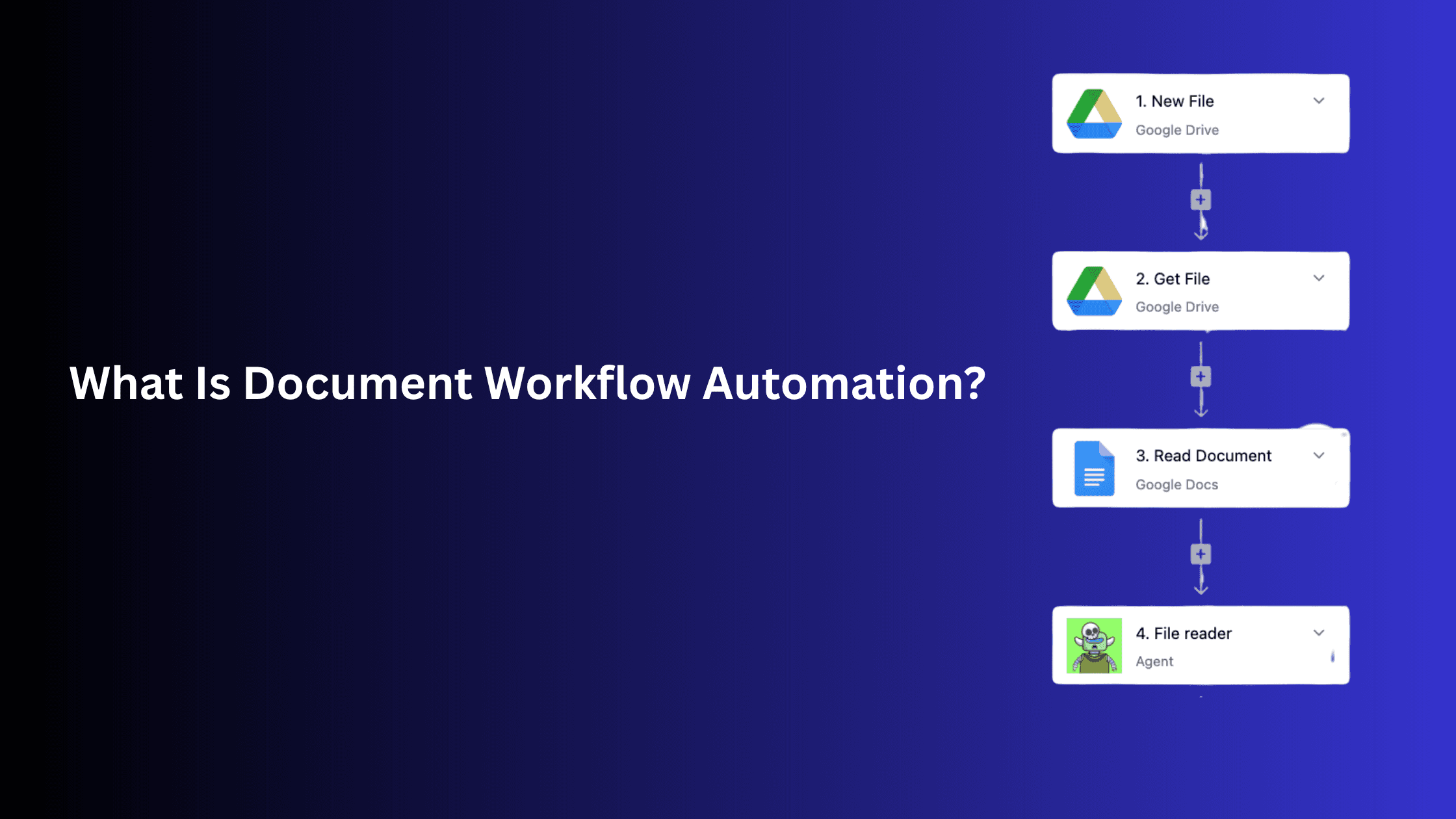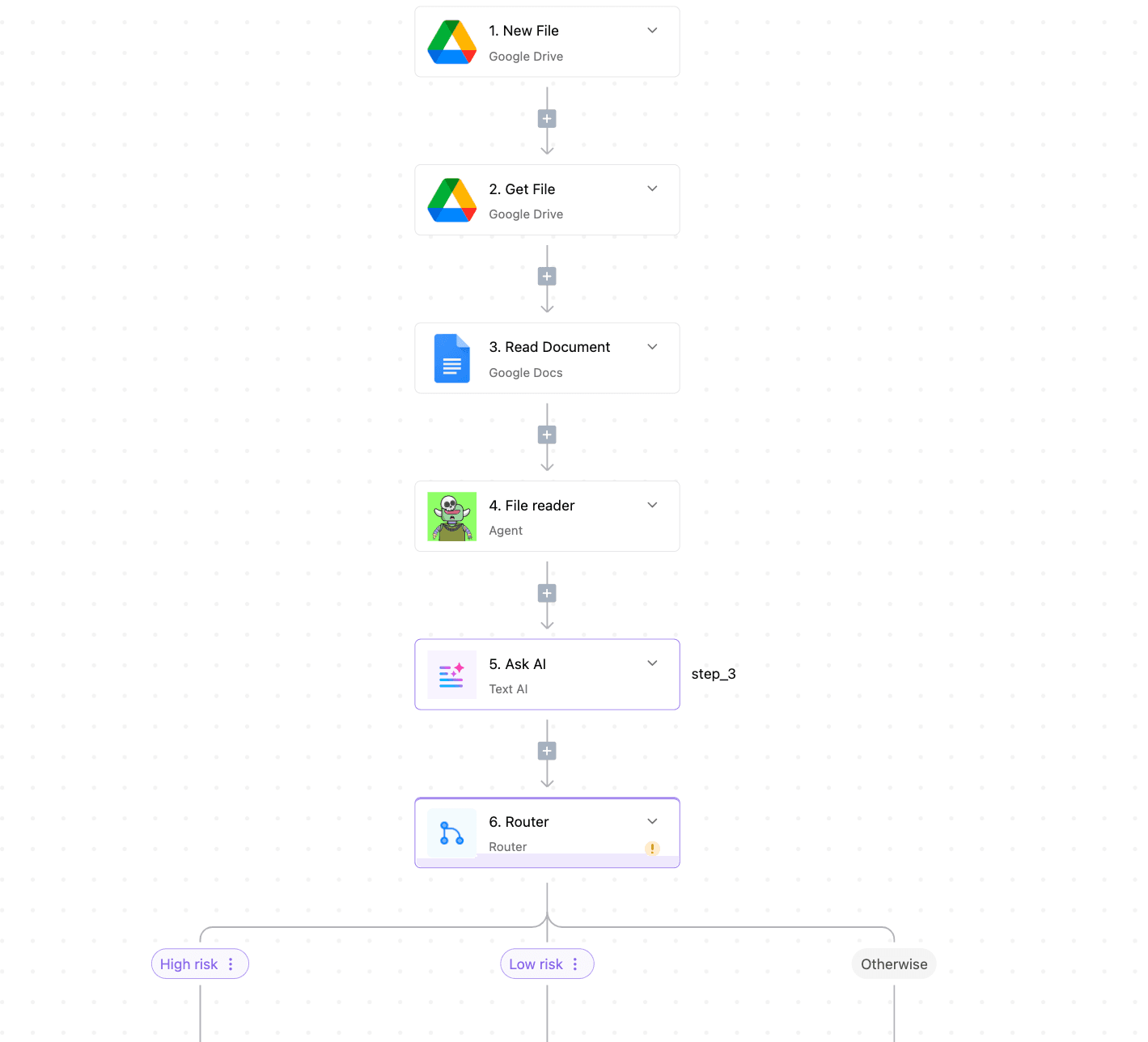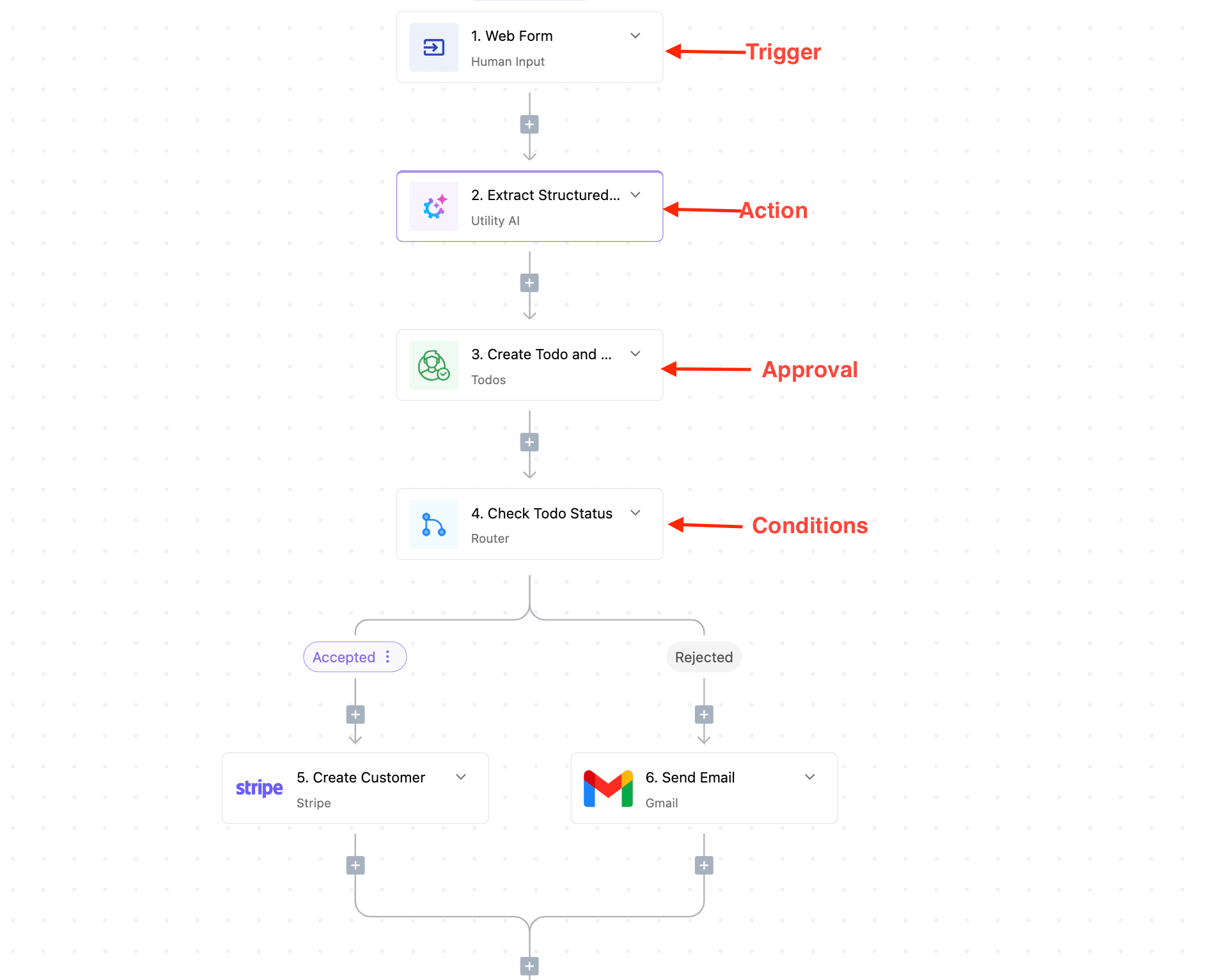What Is Document Workflow Automation? (Features, Tools & Use Cases)

Document workflow automation is what happens when you finally get tired of stalking coworkers in the break room for signatures, endless email threads, or printing out the “final_final_v3.pdf” just to get a signature.
The chaos of manual document handling gets replaced with a system that quietly does the chasing for you, collecting info, routing approvals, sending notifications, and even securing e-signatures.
In this article, we’ll break down what document workflow automation really is, why it’s become essential for modern teams, and the best tools turning workplace chaos into streamlined, stress-free processes.
What is Document Workflow Automation?
Document workflow automation is the process of automating any process that involves documents, like forms, contracts, invoices, or reports, using document automation tools. Think of it like setting up a series of instructions for your documents to follow by themselves.
Instead of someone physically carrying a paper, emailing it, or manually tracking its progress, a document workflow automation system guides the document through each required step.
Imagine a document needing five different approvals. Without automation, someone has to send it to the first person, wait for approval, then send it to the next, and so on. With document automation, the system automatically routes the document to each approver in order, sends reminders if needed, and moves it to the next step once approved.
A Visual Example Of Automating Document Workflows with AI Using Activepieces

This is a document automation workflow that retrieves a contract file from a folder, reads the file, and then passes it to AI to analyze and determine the risk level of the contract. Then different actions will be programmed to be taken on the file depending on the risk level
How Does Document Workflow Automation Work?

A document workflow automation system has specific components that tell it what to do, when to do it, and where the document should end up. In this section, we will look at the core elements of document workflow automation.
- Triggers: This is the event that starts the workflow
- Example: A new contract is uploaded, an employee submits an expense report, an invoice arrives in an email inbox, or a form is filled out online.
- Conditions: These are like "if-then" rules that determine what actions should be taken on the documents
- Example: "IF the invoice amount is over $2,000, THEN send it to the large invoice folder."
- Actions: These are the individual tasks the workflow performs.
- Example: Send an email notification, request a signature, and extract invoice data.
- Approval Steps: Some document workflow automation tools like Activepieces have To-do steps where a human is added to the automation loop in case of critical documents.
- Endpoints: This is where the workflow concludes. It's the final destination or status of the document or process.
- Example: Document is archived, contract is signed and filed, invoice is paid, new employee record is created, or a task is marked as complete.
Automated vs. AI-Enhanced Document Workflows
- Automated Workflow: This is where workflow software comes in. The system manages the routing, notifications, and task assignments automatically based on predefined rules. It significantly speeds up processes, reduces errors, and provides clear visibility into where a document is at any given time.
For example, an invoice is scanned and automatically routed via software to the manager for digital approval. Once approved, the system automatically sends it to accounting and records the payment status.
- AI-Enhanced Workflow: This is beyond simply following rules. Artificial Intelligence (AI) adds "intelligence" to the document workflow automation. AI can understand the content of documents, extract key data, and even learn from past patterns to improve the workflow over time ( using AI agents) in the document automation process. For example, an AI-powered document workflow automation system receives an invoice, reads the line items to flag potential fraud, and suggests the correct approver based on the invoice type and historical data, before routing it for approval.
Key Features to Look For in Document Workflow Automation Tools
1. AI Integration (Text Extraction, Summarization, and More)
This is where automation gets really smart. Look for tools that embed Artificial Intelligence (AI) and AI agents to handle tasks that traditionally required human reading and understanding.
- Intelligent Text/Data Extraction (OCR/IDP): This allows the system to read information from documents. Tools with Intelligent Document Processing (IDP) that can understand context, pull out specific data points (like an invoice number or contract clause), and input them directly into your workflow, reducing manual data entry and errors.
- Summarization and Content Analysis: The tool should summarize lengthy documents and identify key themes and sentiment. This can be incredibly useful for quickly assessing contracts, reports, or customer feedback.
- Smart Routing and Decision Making: As discussed, AI can help route documents based on content analysis, making more nuanced decisions.
2. Flexible Workflow Triggers and Conditions
- Diverse Triggers: The software should allow a wide range of triggers to start a workflow. This could be anything from a new email arriving, a form being submitted, a file being uploaded, a date being reached, or even a change in a database.
- Advanced Conditions/Logic: A good tool lets you build complex conditional logic for nuanced situations. This means you can design workflows that adapt to different situations. For example, "If an expense report is over $500 and the submitter is from the Sales Department, then send it to the VP of Sales for approval."
3. Robust Third-Party App Integrations
Your documents and data don't live in a bubble! A powerful automation tool needs to connect seamlessly with other software your business already uses.
- Pre-built Connectors: Look for direct integrations with popular applications like your accounting software (e.g., QuickBooks), CRM (e.g., Salesforce), cloud storage (e.g., Google Drive, Dropbox, SharePoint), HR systems, communication platforms (e.g., Slack, Microsoft Teams), and e-signature tools (e.g., DocuSign).
- API Access: For more custom needs, the ability to connect via Application Programming Interfaces (APIs) ensures that even unique or in-house systems can "talk" to your workflow automation platform. This prevents data silos and ensures smooth information flow across your entire digital ecosystem.
4. Audit Logging, Compliance, and Security
.
- Comprehensive Audit Trails: The system should automatically record every action, change, and approval within a workflow. This means knowing who did what, when, and from where. This detailed logging is vital for accountability and troubleshooting.
- Compliance Features: For industries with strict regulations (like healthcare or finance), the tool should help ensure compliance with standards such as HIPAA, GDPR, or SOC 2. This often includes features for data retention, access controls, and reporting.
- Robust Security and Ability to Self-Host: Look for features like strong encryption (for data in transit and at rest), role-based access controls (meaning people only see what they're supposed to see), multi-factor authentication, and regular security audits to protect your valuable information. If you operate in a strictly regulated industry, it is advisable to self-host so your data resides only in your infrastructure
5. Seamless Collaboration and Handoffs
Documents often require input and review from multiple people or departments.
- Automated Handoffs: The system should automatically route documents and tasks to the next person or team in the workflow once their preceding step is completed. This eliminates manual forwarding and ensures no task gets forgotten.
- Notifications and Reminders: Automated alerts via email or within the application keep everyone informed about pending tasks, approvals, or upcoming deadlines.
- Version Control: When multiple people are working on a document, having a system that tracks changes, allows comments, and maintains a history of all versions is crucial to avoid confusion and ensure everyone is working on the latest file.
- Delegation and Escalation: The ability to delegate tasks if someone is unavailable, or automatically escalate them if deadlines are missed, helps to keep workflows moving smoothly.
6. Ease of Use
You shouldn't need a computer science degree to set up a workflow. Drag-and-drop interfaces and clear instructions are key.
Top Document Workflow Automation Tools in 2025
When we talk about a great document workflow automation tool, we're really looking for something that makes your life easier, your work faster, and helps you avoid those annoying manual errors.
Activepieces is a friendly, open-source tool for building automated workflows and intelligent AI agents. It's designed to be super accessible, so even if you hate code, you can still create powerful automations. Activepieces has a no-code visual flow builder, meaning you can literally drag and drop steps to create your workflow or build AI agents to automate workflows using just natural language (plain English). It has prebuilt connectors to hundreds of apps. Also, being open-source means it's more transparent and allows for greater customization
Ease of Use: This is where Activepieces truly shines. It is intuitive, making it straightforward to get started. Many users praise it for being easy to navigate, even for those new to automation. It is the easiest workflow automation tool on the market today. It also has flexible pricing that allows for unlimited tasks, while other platforms charge per task.
- Make (formerly Integromat)
Make enables you to connect different apps and actions like puzzle pieces.
Ease of Use: While Make is powerful, it can have a steeper learning curve than some simpler tools. The visual builder might take more time to get comfortable, especially with very complex workflows.
- Zapier
Zapier is known for its ability to link thousands of different apps together.
Ease of Use: Zapier is also user-friendly, especially for creating straightforward automations.
- Kissflow
Kissflow provides a no-code platform to easily create forms to collect data, route documents for review and approval, and track their status in real-time.
Ease of Use: Kissflow is designed to be user-friendly and accessible to non-technical users.
Some Document Workflow Automation Use Cases Across Departments
HR
When you hire, you deal with a lot of paperwork like offer letters, contracts, tax forms, benefits enrollment, employee handbooks, and so much more. With document workflow automation, this workload is removed from HR.
For example, when a new hire is confirmed in the HR system, the automation kicks in. It can automatically generate a personalized offer letter, send it for e-signature, and once signed, trigger other forms (like I-9s, W-4s, direct deposit forms).
Faster onboarding means new hires feel welcomed and productive sooner. It reduces HR's administrative burden, allowing them to focus on more strategic initiatives like employee development and engagement. Plus, consistency in documentation helps with compliance.
Legal
Legal departments deal with contracts every single day, and often, these are critical, high-stakes documents that require multiple rounds of review, negotiation, and approval. Manual processes can lead to delays, version control nightmares, and even legal risks.
For example, once signed, contracts are automatically filed in a secure, centralized digital repository with proper version control and access permissions. This makes searching for specific clauses or past agreements incredibly easy and ensures compliance with record-keeping regulations.
Automating this process speeds up contract cycles, reduces errors, improves compliance by ensuring all necessary steps are followed, and provides a clear audit trail of all changes and approvals.
Finance
Finance departments are all about accuracy and efficiency, especially when it comes to money coming in and going out. Invoice approvals and managing vendor information can be incredibly manual and time-consuming, leading to delays in payments, missed discounts, and frustrated suppliers.
Here's how document workflow automation helps finance:
- Automated Invoice Processing: When an invoice arrives (via email, scan, or a vendor portal), document workflow automation tools can automatically capture key data like vendor name, amount, and invoice number. The invoice then automatically routes to the correct department or manager for approval based on predefined rules (e.g., invoices over a certain amount go to a senior manager).
- Vendor Onboarding: New vendor data can be automatically verified and routed for internal approvals before the vendor is added to the system.
- Expense Reports: Employees can submit expense reports digitally, attaching receipts. The system then automatically routes them to managers for approval, and once approved, triggers the payment process.
This means faster invoice processing, timely payments, and potentially securing early payment discounts. It reduces manual data entry errors, provides real-time visibility into financial obligations, and enhances audit trails for better financial control and compliance.
Operations
Every operational team has internal processes, from setting up new projects to managing inventory or handling customer requests. Often, these processes rely on various documents, checklists, and sign-offs that can become bottlenecks if managed manually.
Document workflow automation can streamline these operations.
For example, if maintenance requests are submitted through a form, a workflow for approval, scheduling, and tracking the repair can be triggered.
This ensures consistency in internal processes, reduces manual effort, improves collaboration, and provides clear visibility into the status of various operational tasks.
Healthcare: Patient Intake Forms and Compliance Docs
In healthcare, patient information is not only critical but also highly sensitive and subject to strict regulations (like HIPAA). Manual handling of patient intake forms, medical records, and compliance documents can lead to errors, delays, and security risks.
Here are some ways document workflow automation is vital in healthcare:
- Patient Intake Automation: Before an appointment, patients can fill out digital intake forms from home. This data is then automatically transferred to an electronic health record (EHR) system, saving time at check-in and reducing data entry errors.
- Consent Forms: Electronic consent forms can be presented to patients on tablets, with digital signatures captured directly. These are then automatically stored in the patient's file.
- Compliance Documentation: For things like incident reports, audit logs, or regulatory submissions, automated document workflows ensure that all necessary information is collected, reviewed, and approved according to strict protocols. The system can even flag missing information or potential compliance issues.
How Does Document Workflow Automation Differ From Document Management?
- Document Management is primarily about organizing, storing, and securing your documents. Think of it like a highly efficient digital filing cabinet and library. A document management system allows you to:
- Store all your documents in one central, searchable place.
- Control who can access, edit, or view specific documents (permissions).
- Keep track of different versions of a document.
- Ensure documents are retained for compliance purposes.
- Make it easy to find specific documents when you need them.
- Document Workflow Automation, on the other hand, is about making your documents actively move and do things based on predefined rules. While a document management system stores the document, a document workflow automation system dictates what happens to that document at each stage of a process. For example:
- Receiving an invoice and automatically sending it for approval based on its value.
- Taking a signed contract and automatically filing it in the correct folder within your document management system.
- Generating a new personalized onboarding document for a new hire using existing data.
Cloud vs. Self-Hosted Document Workflow Automation Tools
This is one of the first big decisions you'll face, and it's like deciding whether to rent an apartment (cloud) or buy and maintain your own house (self-hosted).
- Cloud-based (SaaS - Software as a Service): The software lives on the vendor's servers, and you access it over the internet, usually through your web browser.
Pros:
- Easier to start: No need to buy expensive servers or have a dedicated IT team to set it up. You just sign up and go
- Lower upfront cost: You typically pay a monthly or annual subscription fee, making budgeting predictable.
- Automatic updates and maintenance: The vendor handles all the technical stuff like security patches, new features, and keeping the system running.
- Scalability: It's usually easy to scale up or down as your needs change, often with just a few clicks or a plan upgrade.
- Accessibility: You can access your workflows and documents from anywhere with an internet connection.
- Cons:
- Less control: You rely on the vendor for security, uptime, and features.
- Data residency: Your data might be stored in a different country, which can be a concern for some industries or compliance regulations.
- Ongoing costs: While lower upfront, subscription fees add up over time.
- Reliance on the internet: If your internet goes down, so does your access to the tool.
- Self-hosted (On-premises): You install and run the software on your own servers within your company's physical location or private cloud.
- Pros:
- Full control: You have complete control over data security, customization, and upgrades.
- Data security & compliance: Ideal for organizations with strict data governance rules (like in healthcare or finance) who need to keep all data within their own infrastructure.
- Potentially lower long-term cost (sometimes): After the initial large investment, ongoing costs might be lower if you have the internal resources to manage it.
- Cons:
- High upfront cost: Requires significant investment in hardware, licenses, and IT staff.
- More responsibility: Your team is responsible for all maintenance, security, updates, and troubleshooting.
- Scalability challenges: Scaling up often means buying more hardware, which can be slow and expensive.
- Accessibility limitations: It might be harder for remote employees to access securely without proper infrastructure.
- Pros:
Most smaller to medium-sized businesses and those looking for quick deployment will lean towards cloud solutions. Larger enterprises or highly regulated industries with specific data control needs might consider self-hosted options.
Next Steps: Your Journey to Smoother Document Workflows
The best way to understand the power of document workflow automation is to experience it yourself.
Your Next Steps:
- Explore the Possibilities: Think about the most frustrating, repetitive document tasks in your day or your department. Could it be invoice approvals, onboarding forms, or perhaps contract routing?
- Try a Template: Activepieces offers fantastic pre-built templates for common workflows. This is an excellent way to get a feel for how they work without starting from scratch.
- Start Small, Think Big: You don't have to automate your entire business overnight. Pick one small, but impactful, document-heavy process. Get it automated, see the benefits, and then you can gradually expand to other areas.
Sign up for a free Activepieces account here: https://www.activepieces.com/
Related articles:


